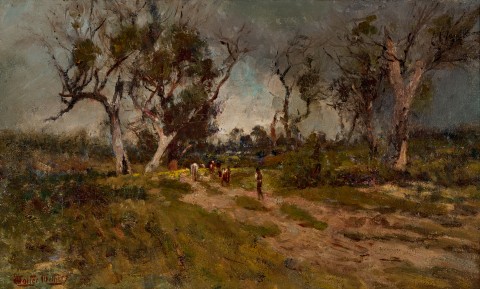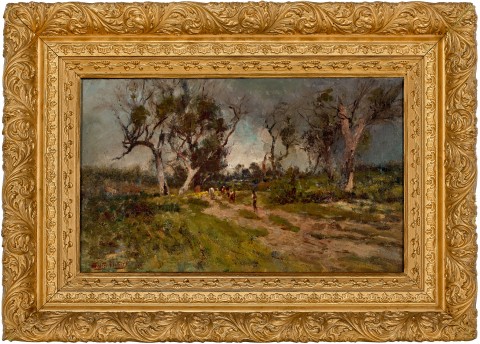A coming storm, c.1898
Walter Withers
oil on canvas
31.0 x 51.0 cm
signed lower left: Walter Withers
bears inscription on Tasmanian Museum and Art Gallery label verso: The Coming Storm
Estate of the artist, until 1926
Sedon Galleries, Melbourne
Ross Mackenzie, Tasmania, acquired from the above
Thence by descent
Private collection, Melbourne, acquired c.1980s
Christie's, Melbourne, 3 – 4 May 2004, lot 98 (as 'The Coming Storm, Winter')
Private collection, Melbourne
Possibly: 3rd Annual Exhibition of the Yarra Sculptors Society, Yarra Sculptors' Society, Melbourne, 1901, cat. 13 (as 'A Coming Storm')
Art Union of Paintings by the Late Walter Withers and his Son Meynell Withers, Sedon Galleries, Melbourne, 3 - 15 May 1926, prize 12
on long term loan to the Tasmanian Museum and Art Gallery, Hobart, 1974 - 1980 (label attached verso)
Mckenzie, A., Walter Withers: The Forgotten Manuscripts, Mannagum Press, Victoria, 1987, p. 42
In 1897, Walter Withers began a sequence of paintings of winter storms featuring atmospheric renderings of turbulent skies threatening farmers and their cows. The first of these, The storm, 1897, was the inaugural winner of the Wynne Prize at the Art Gallery of New South Wales, subsequently entering their collection and becoming a firm favourite with gallery visitors. Others in the series include: The coming storm – the last of summer, 1898 (Ballarat Art Gallery); Winter afternoon, c.1899 (National Gallery of Victoria); and After storm, c.1898 (private collection, Melbourne). As their titles imply, Withers had ‘a strong feeling for winter with its intimate variety of movement and colour, and though he painted sunlight, and painted it well, storm-charged murky skies and a wet terrain seem to have had an enduring charm for him.’1 A coming storm, c.1898, is a notable inclusion to the series, one with ‘the boldness and vigour of a quickly executed sketch (but) with the masterly finish of an accomplished and inspired hand.’2
The English-born Withers first trained in London at the Royal Academy of Arts before emigrating to Australia in 1883. For the first eighteen months, he worked as a jackaroo on several country properties ‘but the eucalyptus had got into his veins and Australia claimed him.’3 In 1885, he began further studies at the National Gallery School under George Folingsby, where a fellow student was Tom Roberts, recently returned from Europe and eager to apply his newly acquired plein air enthusiasm to Australian landscape painting. Folingsby famously declared that ‘the man who paints landscape in the open air is a fool’4; he didn’t necessarily dismiss outdoor sketching but preferred a studio finish to the final piece, a strategy that Withers pursued in works such as Coming storm. The setting was near his home in the Melbourne suburb of Heidelberg which was then ‘very much like a small English village, with fruit trees and English gardens surrounding the old homesteads.’5 These in turn were bordered by farm lots and the sight of farmers walking their herds was common. Despite the artist’s close association with members of the Heidelberg School, A coming storm shows the strong influence of John Constable’s low-toned, lyrical landscapes of the English countryside – although areas of broad brushstrokes in the foreground invite comparisons with Arthur Streeton, whilst the stark white gum trees could only have been painted through responsive ‘Australian’ eyes. With the lower clouds of the tempest backlit by the sun, the lone farmer urges his small herd to safety in a scene that will soon be transformed by wind and rain. Following Folingsby’s directive, A coming storm would no doubt have begun as a plein air sketch before being fleshed out to its final version within Withers’ self-built Heidelberg studio.
1. ‘Melbourne’s private art galleries. Mr John May’s collection. The art of Walter Withers.’, The Age, Melbourne, 12 April 1930, p. 5, at: https://trove.nla.gov.au/newspaper/page/18959684 (accessed 4 September 2025)
2. Withers, F., The life and art of Walter Withers, Alexander McCubbin, Melbourne , 1920, p. 23
3. ibid. p. 11
4. George Folingsby, cited in MacDonald, J., The art of F. McCubbin, Lothian Publishing, Melbourne, 1916, p. 56. In this text, McDonald spells the name as ‘Folingsbee’.
5. Mackenzie, A., Walter Withers: the forgotten manuscripts, Mannagum Press, Victoria, 1987, p. 26
ANDREW GAYNOR


